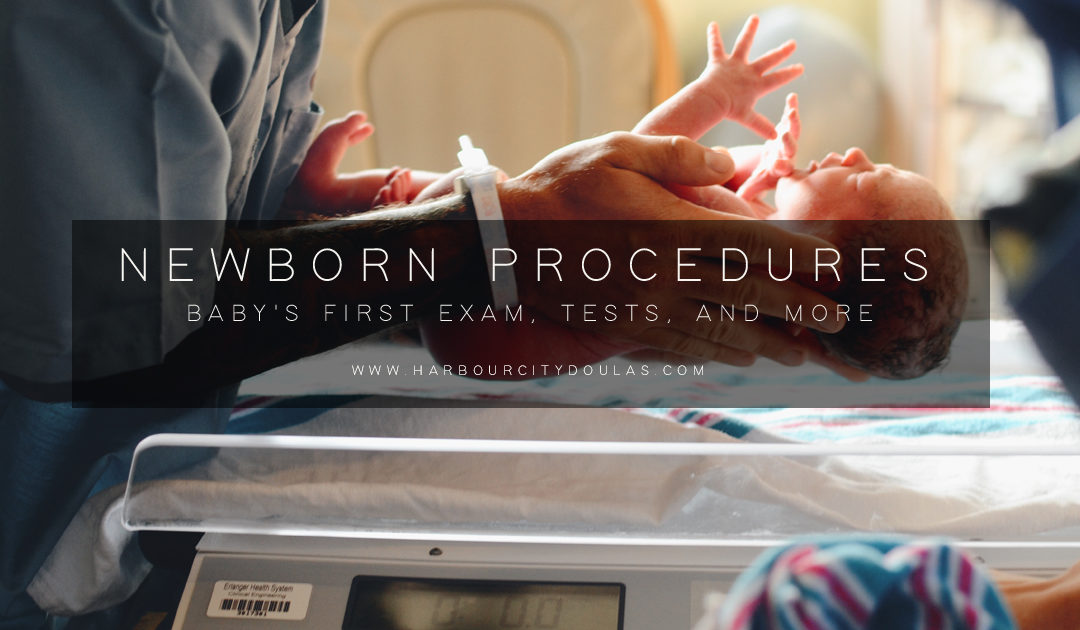There’s so much info available to expecting parents on their options for birth and you know us: #wesupportthat! Knowledge is power, and the more info you have, the better you’re able to make decisions in your labour about things like fetal monitoring, inductions, cervical exams, and so much more (don’t know about any of that yet? Consider signing up for one of our Childbirth Education classes!).
One area you might not have covered in your research yet is the standard newborn procedures that are offered in the first hour or so after your baby is born. Understanding what these procedures are, why they’re offered, and what options you have will help you make some of your first decisions as parents!
Newborn Exam
The newborn exam is a general head-to-toe exam to check on your baby’s well-being. Your nurse or care provider will check your baby’s color, heart rate, reflexes, joints, and temperature, as well as weigh and measure your baby. It usually takes about 10-15 minutes, and takes place on the warmer beside your bed.
Some parents choose to delay the newborn exam until after they’ve had a chance to say hello, bond with their baby, and perhaps after they’ve attempted breastfeeding. Holding your baby skin-to-skin and undisturbed for at least the first hour after birth has a ton of positive benefits, including regulating your baby’s temperature, helping them establish breathing and circulatory rhythms, and helping both of you recover from birth. Unless your baby is born with breathing difficulties, it’s safe to delay their newborn exam until you’re both ready for it!
Vitamin K Injection
A small injection of Vitamin K is recommended for all newborns to prevent a rare, but potentially fatal, condition called hemorrhagic disease of the newborn or Vitamin K Deficiency Bleeding (VKDB). It’s a quick injection given to babies in the upper thigh, usually during their newborn exam. You can request that the injection be given while you’re breastfeeding or holding your baby skin-to-skin to help reduce their pain (yes, skin-to-skin does that too!).
Vitamin K is responsible for blood clotting. We don’t make it, or store it very well in our livers. Babies are born with little to no stored Vitamin K, which may increase their risk for developing VKDB or spontaneous hemorrhage. To learn more about what Vitamin K is, what it does, and why it’s important, we always recommend you talk to your care provider and check out Evidence Based Birth’s article about Vitamin K.
Erythromycin/Antibiotic Eye Ointment
This antibiotic ointment is applied to some newborn’s eyes shortly after birth (again, typically during the newborn exam). It’s intended to protect baby’s eyes from developing infections or potential blindness from any infections present in the vagina, typically chlamydia and gonorrhea. Many people choose to decline this ointment if their prenatal testing shows that they are not carrying or at risk for these infections. If you do choose to have the ointment applied, you may decide to delay it for an hour or so after your baby has had a chance to look around and bond with you.
Heel Prick/Newborn Screen
This screen, also known as the heel prick test, is done once your baby is at least 24 hours old. It’s baby’s first blood test, and is early detection for 24 potentially life-threatening disorders like cystic fibrosis, metabolic disorders, and blood disorders.
This test involves wrapping your baby’s foot in a warm blanket to encourage blood to flow to the area, and then a quick jab to produce blood for a sample. Most babies cry (and many parents cry right along with them), but it’s generally over within a few minutes. Again, breastfeeding or holding your baby skin-to-skin during this procedure will help make it easier on them.
If your care team is concerned about your baby’s glucose levels, or if you had gestational diabetes, your baby many need additional heel prick tests to check their glucose.
Hearing Test
Your baby’s hearing test is a quick, pain-free (yay!) test which involves a tiny, soft earphone placed in your baby’s ear. Quiet sounds are played, and your baby’s response is recorded either through the earphone or through small sensors placed on your baby’s head. This test can be done while you hold your baby and while they’re sleeping, and it usually only takes a few minutes. You’ll get the results right away. Most babies pass, but if yours doesn’t, don’t worry- it doesn’t mean they can’t hear, it just means that they need another test.
Jaundice Screen
Jaundice is a slight yellowing of the baby’s skin due to an excess of bilirubin, which is caused by too many red blood cells. Most newborns experience at least slight jaundice during the first few days of life. Generally, it goes away all on it’s own within a few days with increased feeding. If your baby is showing signs of jaundice (sleepiness, reduced feeding, and yellow looking skin or eyes), your nurse or midwife may use a small bedside jaundice screening meter to scan and “read” your baby’s skin (kind of like a thermometer). It’s quick, painless, and can be done while you’re holding your baby.
Of course, each and every procedure is up to you and as your baby’s parents, you’re the only one who gets to decide which ones happen. If you have questions about these procedures, how they’re done, or why they happen, we always encourage you to check in with your doctor or midwife. Your doula can also provide you with info about these procedures, help you understand your options, and help you make a plan for your baby that you feel good about. No matter what you choose to do, you’re calling the shots (and you know #wesupportthat!)

Recent Comments